- Category
- Anti-Fake
How Russia Tried To Convince The World That Ukraine Was Selling Western Weapons on the Black Market
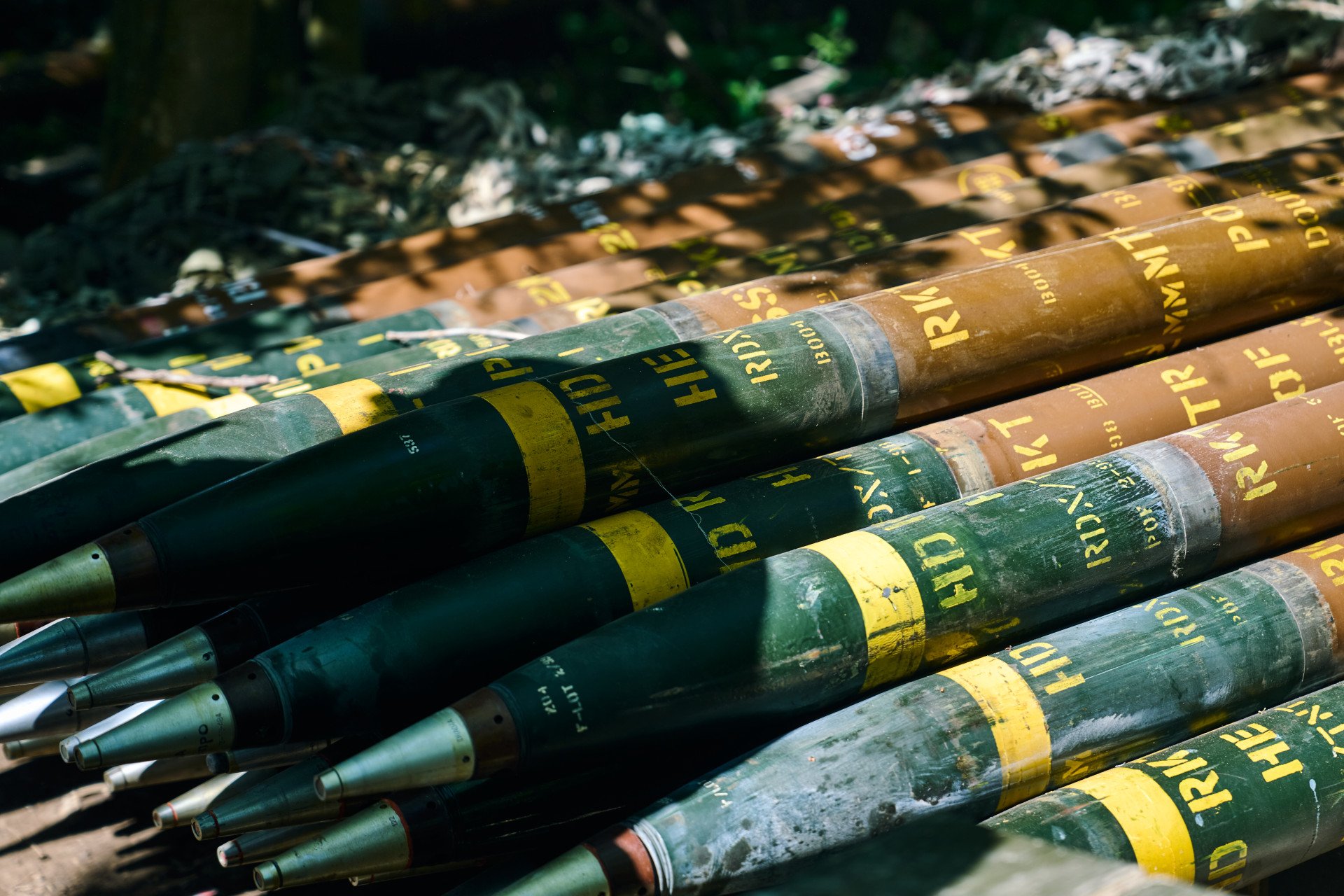
Fake ads, Mexican drug cartels, interviews with anarchists and much more. Here’s what you need to know about Russia’s intricate disinformation campaign that tried to manipulate global public opinion on supplying weapons to Ukraine.
This morning, Ukraine’s Main Directorate of Intelligence announced that Russia is plotting a provocation by planning to spread fabricated images of partner weapons given to Ukraine being used in Sudan. But this is only the latest in a string of attempts by Russia to use its propaganda machine to erode trust in Ukraine, as it seeks weapon supplies from partners to defend itself.
A new study has found proof of a deliberate Russian disinformation campaign to establish a false narrative across multiple countries that “Ukraine is selling donated weapons” and is “the main factor of destabilization in all hot spots of the world”. After having studied over 10,000+ mentions in articles, Telegram channels, and social media posts, Ukraine’s Center for Countering Disinformation (CCD) has tracked its timeline, examples, and sources.
Russia has become notorious for the sophisticated disinformation machinery it employs to interfere in the domestic affairs of states and influence global developments by sowing discord. Using a comprehensive propaganda playbook and ecosystem, Russia orchestrates the dissemination of false narratives to advance its strategic objectives. This study, once again, proves that Russia's arsenal of manipulation is vast and multifaceted, and we must understand it if we want to effectively respond.
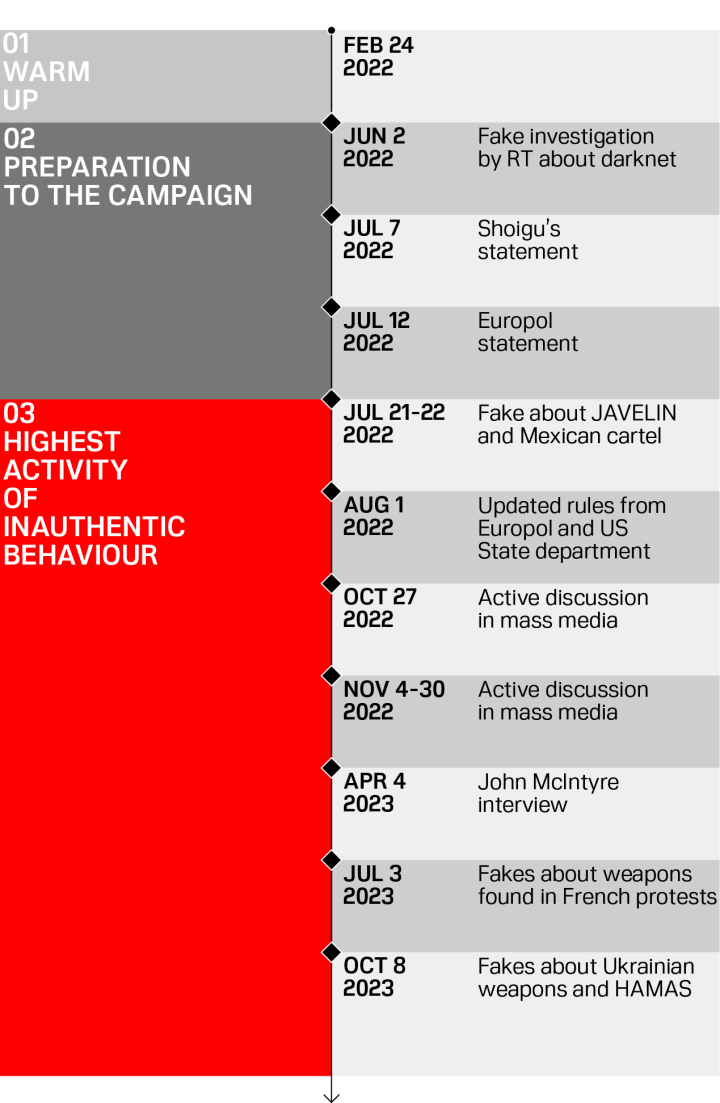
Planting the narrative
It all started when Ukraine began to campaign for weapon supplies from partners to protect itself from Russia’s full-scale invasion in 2022. That is when Russia, the invading authoritarian power, launched a mass disinformation campaign to disseminate fabricated proof as to why giving Ukraine weapons was detrimental to the security of the world. Their main goal was to artificially create an impression amongst global audiences that weapons provided to Ukraine would be smuggled out of the country and would end up “in the hands of terrorists and criminals.” Three main sources lay the groundwork for Russia’s initial disinformation push.
Fake ads
At the root of this hostile disinformation campaign were fake adverts on the dark web, which started gaining traction in the summer.
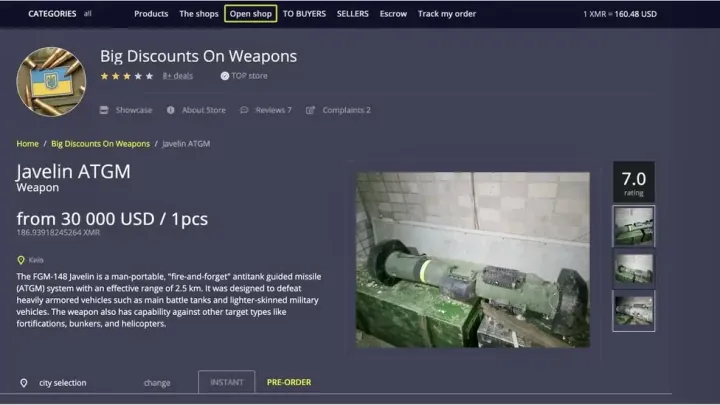
On June 2, 2022, a pro-Russian Bulgarian news website published an article alleging that “the FGM-148 Javelin is being sold on the darknet for $30,000.” Its source was a Telegram post from a pro-Russian channel called ASB Military News—with more than 1000,000 subscribers. It included screenshots of an ad apparently selling a Javelin online from Ukraine’s capital. Another account—with 700,000 followers—published a post with a similar message. Both were picked up by mainstream Russian state TV and distributed to the masses.
Russia Today’s “investigation”
Fake adverts were then used in a Russia Today (RT) “investigation” that acted as a primary resource for those spreading disinformation further. On July 1, 2022, the Russian propaganda outlet released their “investigation” about an alleged deal to sell a Phoenix Ghost system and a batch of American M18A1 Claymore anti-personnel mines that were supposedly handed over to Ukraine by its partners. Once published, Russian disinformation agents and networks began a large-scale operation to spread these lies.
Shoigu’s statement
On July 5, 2022, at a meeting of the Ministry of Defense of the Russian Federation, Russia’s Minister of Defense Sergei Shoigu, said the following:
“According to the available data, part of foreign weapons supplied by the West to Ukraine are spread throughout the Middle East region and also end up on the black market.”
His statement, published online, referenced the RT above “investigation” and gave it legitimacy in the Russian information space. This—together with an orchestrated push from Russian disinformation networks online and in the media—allowed the fabricated narrative to spread to the rest of the world.
The initial wave of Russian disinformation sparked heightened concern about the potential sale of weapons provided by partners to Ukraine on the illicit market. Within just a week of Shoigu's statement, the public began discussing the topic actively, and major Western publications like the Financial Times started to publish articles on it. It's likely what triggered discussions at the EU level, leading to Europol's first statement in July 2022.
How do we know the ads are fake?
An investigation by the BBC World Service Disinformation Team gathered evidence that suggested the adverts for weapons from at least one marketplace—used by Russian state media as proof—were fake. This was also confirmed by research done by the CCD and others.
Russian media reports often mentioned a seller under the name "Weapons Ukraine," claiming 32 successful deals. The BBC found that many of the photos of the weapons used were from 2014. Another seller—who claimed to be selling NATO weapons given to Ukraine—was found to have photoshopped old photos of a drone that matched one that was shot down in Syria in 2015 and 2016.
Linguists consulted by the BBC also concluded that the messages sent from one seller to undercover BBC investigators were from someone who was Russian-speaking due to “substantial evidence that the messages written in Ukrainian were translated from Russian with the help of an online translator.” They also found that a lot of the sellers who claimed to be selling NATO weapons from Kyiv had misspelt Ukraine’s capital in Ukrainian—writing “Kiev” (the Russian way to spell it.)
A cybercrime threat intelligence company quoted in the BBC article also said that there was relatively low activity in the marketplace that was so often mentioned by Russian state media. Therefore, it was questionable “how Russian journalists found [the marketplace] so easily.”
Despite all these inconsistencies, Russian state media had no problem with using these ads as evidence—to sow panic in the European Union and beyond.
Tailoring disinformation to local contexts: Mexican drug cartels
Russian fakes about the alleged sale of weapons given to Ukraine by partners continued to permeate the public domain. The fake news and disinformation materials they produced varied depending on the context, allowing them more flexibility to shape their narrative about the "black market of weapons" to suit different audiences. One such case is that of Ukrainian Javelins allegedly being sold into the hands of a Mexican Cartel—causing a big discussion within the country.
On August 1, 2022, Russian mass media and Telegram channels—with reference to the Mexican TV channel Milenio Televisión—published a video about the alleged sale of weapons provided by Ukraine to a Mexican drug cartel. The video mentioned dozens of American M136 grenade launchers, AK-47 assault rifles, and Javelin ATGMs—which were supplied to Ukraine by the USA.
However, after carefully watching the video, it becomes evident that the presenter makes a mistake and calls an M136 AT4 anti-tank grenade launcher a “Javelin”. This is an important clarification, since the AT4 grenade launcher has been mass-produced since the 1980s, and the total number of manufactured units currently exceeds 600,000. Considering this fact, it’s entirely possible that the launcher was purchased on the North American “black market” and not shipped from Europe.
Yet, Russian state media RT en Espanol picked this story up–with no mention of the mistake of the presenter about the Javelin–and ran with it.
Of course, the Russian Embassy in Mexico made a statement too. The news caused a high resonance in the Mexican public domain and led to a great demand for additional information from the local population. The Russian Embassy released a statement that filled this vacuum, saying that “the Kyiv regime is pumped with Western weapons and resells them to Mexican cartels”.
Later, neutral Spanish-language media picked this story up and spread the Russian Embassy’s statement. For example, EL FINANCIERO, a publication that focuses on the topic of economics, published the statement of the Russian Embassy in almost its entirety—-inadvertently legitimising it.
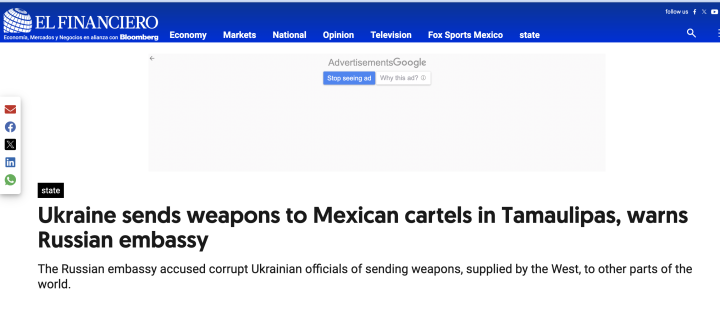
Russia manipulates official statements
The absolutely logical desire of partner countries to introduce mechanisms for tracking and regulating the process of providing arms to Ukraine, though likely influenced by the active discussions on the topic caused by Russian disinformation, created a number of vulnerabilities that Russia began to actively take advantage of as part of their campaign.
On October 27, 2022, the European Commission’s website published updated rules to improve security and strengthen the fight against the illegal sale of weapons. On the same day, the US State Department also published its plan for monitoring Western weapons in Ukraine. Both included a list of new procedures to ensure that weapons would not be disseminated back into Eastern Europe.
Russian mass media began to use these statements in a manipulative manner by first spreading the news that Western partners were “worried” and therefore decided to create a new command to oversee the training and arming of the Armed Forces of Ukraine. Then they supplemented this by adding “testimonies” of the Ukrainian military about selling weapons abroad to provide fake “proof” to these concerns. This further fuelled the narrative that Ukraine was not to be trusted with weapons.
CPD detected signs indicating the use of networks of fake accounts to amplify the dissemination of key messages found in Russian mass media. The main manifestation of such use was the involvement of pseudo-experts on social media and trolls to create an artificial discussion.
American mercenary John McIntyre and the “tankies”
In March 2023, information started appearing about an American mercenary John McIntyre, who allegedly participated in combat operations as part of the International Legion of Territorial Defence of the Armed Forces of Ukraine and then switched to the Russian side.
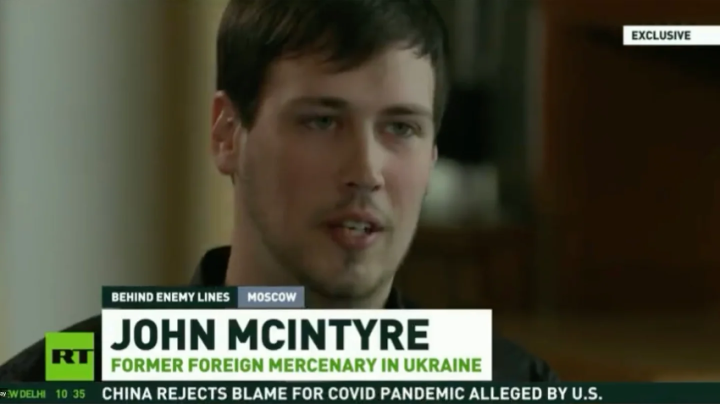
He stated that he was an outspoken communist and anti-fascist—aligning himself with a far-left communist community, often referred to colloquially as “tankies”. This community, primarily composed of young people, often falls prey to Russian propaganda and frequently rationalizes the actions of historical figures like Stalin and Mao, notorious for their mass atrocities.
During April, McIntyre granted multiple interviews to Russian media, notably RT, articulating assertions concerning the Armed Forces of Ukraine. Among these false claims were allegations of weapon sales on the black market, alleged brutality towards prisoners, and accusations of the misappropriation of American weaponry. One of the interviews was in English, with the main message being “the US should stop providing aid to Ukraine and help its own people.”
This served as a catalyst for others within the far-left community to start supporting Russia and mistrusting Ukraine. It was also followed by a series of interviews on RT and messages by pro-Russian spokespeople spread across the public domain—including a speech by Chey Bowes at the UN Security Council meeting convened by Russia.
Big global moments to push the narrative
When protests erupted in France in the summer of 2023, fake information appeared that participants of the protests allegedly wounded seven policemen with the same type of rifles that France had previously handed over to Ukraine.
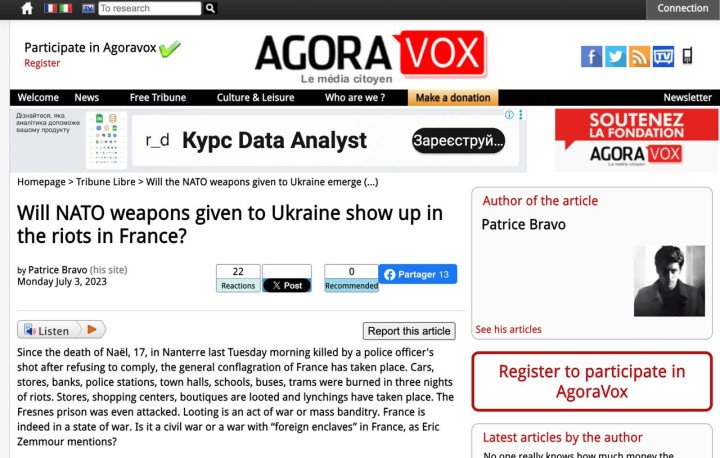
On July 3, 2023, the French publication Agoravox published an article about the possibility of “NATO” weapons given to Ukraine appearing back in France. According to CCD, the website is mostly used as a blog for the right-wing radical community in France. This was also picked up by right-wing sceptic and leader of French political party “Reconquest”, Eric Zemmour.
Of course, all of the above was used by Russian propagandists—including the spokeswoman for Russia’s Foreign Ministry Maria Zakharova—to further spread the narrative of Western military aid to Ukraine ending up on the black market. Similar tactics were used to spread fakes about Ukrainian weapons and Hamas, and many investigations have uncovered Russia’s disinformation networks on the topic.
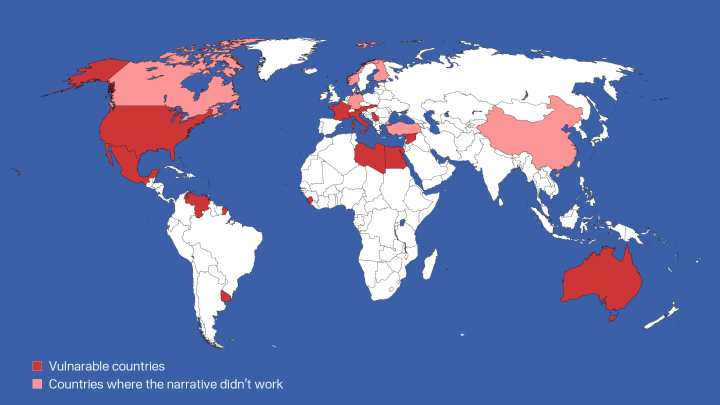
Understanding how Russian propaganda is modernizing
In May of 2023, almost a year after the initial push of Russian propaganda, the European Commissioner for Internal Affairs Iva Johansson told Reuters that “we have not seen a single cause of industrial smuggling of firearms from Ukraine. They were mostly people trying to take weapons out as trophies or for personal protection, who are of course detained at the border.” The lack of a systematic approach to the issue is evident, but Russia's disinformation campaign succeeded in sowing seeds of doubt about Ukraine's reliability among many. CCD believes that the data they gathered shows a clear pattern—that nations with robust trust in governmental institutions and stringent firearm regulations were less susceptible to the dissemination of misinformation. Conversely, regions grappling with economic and social turmoil proved more susceptible to the insidious narrative portraying Ukraine as a hub for illicit arms trade.
This campaign has once more highlighted the typical strategy of Russian propaganda: fabricate a falsehood, amplify it through state media and official statements, disseminate it globally via social media networks, gain traction in international media, choose powerful messengers for vulnerable audiences, then recycle international reactions back into Russian state media as supposed evidence of support, thus solidifying the narrative.
This is just one of many hostile disinformation campaigns that Ukraine’s Center for Countering Disinformation has tracked in recent years. Tracking the specific sources and tools used to spread harmful narratives by Russia can allow us to better respond to the threats its propaganda machine presents us with.


-46f6afa2f66d31ff3df8ea1a8f5524ec.jpg)
-8ddd9e24f95bb9d73d6d11d75f774999.png)
-29a1a43aba23f9bb779a1ac8b98d2121.jpeg)
-283d77c1379d612e6f72cf1b6de7dacb.png)
